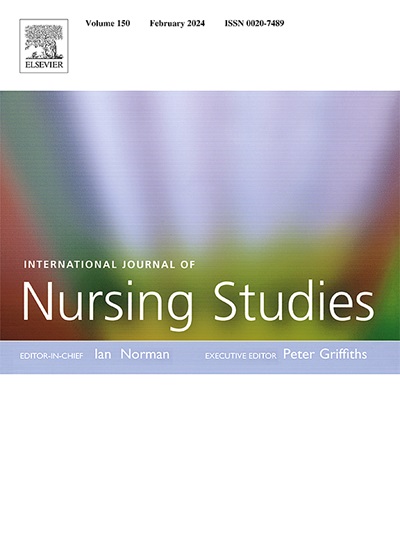影响护士和助产士职业暴露于危险药物的知识和安全处理方法:混合方法系统综述。
IF 7.5
1区 医学
Q1 NURSING
引用次数: 0
摘要
背景:危险药物本身具有毒性,对护士和助产士构成潜在的职业接触风险。危险药物需要特殊处理,以尽量减少接触风险和对健康的不良影响。尽管在肿瘤服务中使用危险药物已得到广泛认可,但在其他医疗保健领域也在使用危险药物,而护士和助产士可能并未意识到存在风险:调查护士和助产士对其职业接触危险药物的了解和做法,以及影响其了解和做法的因素:混合方法系统综述:进行系统综述,如果作者描述了护士或助产士对危险药物的了解,或他们在临床实践中为降低职业暴露风险所做的工作,则纳入研究(PROSPERO 注册号 CRD42024437493)。两位独立审稿人使用 Covidence 提取数据并评估偏倚风险。提取的数据分为风险知识和安全处理方法、态度和影响这些的因素以及具有最大暴露风险的活动(配制、使用和处置危险药物、清理危险药物泄漏以及处理近期接受过危险药物治疗的患者的排泄物)等类别:在已确定的 2702 篇文章中,有 59 篇定量研究和 3 篇定性研究被纳入本综述。没有关于助产士处理危险药物的研究报告。大多数研究对在肿瘤科工作的护士进行了调查。据报告,护士缺乏有关风险和安全处理的教育。她们通常负责配制危险药物,在使用个人防护设备时,她们的依从性也不一致。护士并不总是认为存在真正的接触风险,担心穿戴个人防护设备会影响他们与病人的关系,并认为他们没有时间穿戴设备:结论:很少有人调查过肿瘤服务以外的职业接触危险药物的风险。没有研究报告助产士对其职业接触危险药物风险的认识和做法。Tweetable摘要:护士和助产士在为患者准备和使用危险药物时,往往会在不知情的情况下接触到这些药物的毒性作用,尽管知识并不总是等同于安全的操作方法。本文章由计算机程序翻译,如有差异,请以英文原文为准。
Knowledge and safe handling practices affecting the occupational exposure of nurses and midwives to hazardous drugs: A mixed methods systematic review
Background
Hazardous drugs are inherently toxic and present a potential occupational exposure risk to nurses and midwives. Hazardous drugs require special handling to minimise the risk of exposure and adverse health effects. Although the use of hazardous drugs in oncology services is well recognised, they are also used in other healthcare areas where nurses and midwives may be unaware there is a risk.
Objective
To investigate what nurses and midwives know and do about their occupational exposure to hazardous drugs, and what factors affect their knowledge and practice.
Design
Mixed methods systematic review.
Methods
A systematic review was conducted, and studies were included if the authors described what nurses or midwives knew about hazardous drugs, or what they did in their clinical practice to reduce their risk of occupational exposure (PROSPERO registration CRD42024437493). The databases were searched for any year until the 26th of January 2024.Two independent reviewers extracted data using Covidence and assessed the risk of bias. The data were extracted into the categories of knowledge of risk and safe handling practices, attitude and factors affecting these, and activities that posed the greatest risk of exposure (preparation, administration, and disposal of hazardous drugs, cleaning hazardous drug spills, and handling excreta from patients who had recently been treated with hazardous drugs).
Results
Of the 2702 articles that were identified, 59 quantitative and 3 qualitative studies were included in this review. No studies reported on midwives handling hazardous drugs. Most studies investigated nurses working in oncology services. Nurses reported a lack of education about the risk and safe handling. They were often responsible for preparing hazardous drugs and there was inconsistency in their compliance when using personal protective equipment. Nurses did not always perceive that there was a real risk of exposure, were concerned about the effect of wearing personal protective equipment on their relationship with patients and perceived they lacked the time to don equipment.
Conclusions
The risk of occupational exposure to hazardous drugs outside of oncology services was rarely investigated. There were no studies reporting what midwives knew and did about their risk of occupational exposure to hazardous drugs. When nurses were aware of the risks, this did not necessarily translate into the implementation of safe handling practices or the consistent use of personal protective equipment because of a perceived low risk, lack of personal protective equipment availability, and prioritising personal or patient comfort over safety measures.
Tweetable abstract: Nurses and midwives are often unknowingly exposed to the toxic effects of hazardous drugs when they prepare and administer these drugs for patients, although knowledge does not always equal safe handling practices.
求助全文
通过发布文献求助,成功后即可免费获取论文全文。
去求助
来源期刊
CiteScore
15.00
自引率
2.50%
发文量
181
审稿时长
21 days
期刊介绍:
The International Journal of Nursing Studies (IJNS) is a highly respected journal that has been publishing original peer-reviewed articles since 1963. It provides a forum for original research and scholarship about health care delivery, organisation, management, workforce, policy, and research methods relevant to nursing, midwifery, and other health related professions. The journal aims to support evidence informed policy and practice by publishing research, systematic and other scholarly reviews, critical discussion, and commentary of the highest standard. The IJNS is indexed in major databases including PubMed, Medline, Thomson Reuters - Science Citation Index, Scopus, Thomson Reuters - Social Science Citation Index, CINAHL, and the BNI (British Nursing Index).

 求助内容:
求助内容: 应助结果提醒方式:
应助结果提醒方式:


